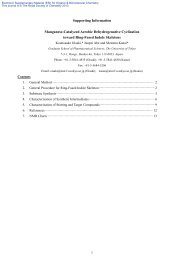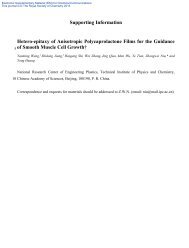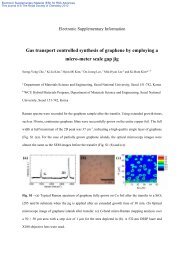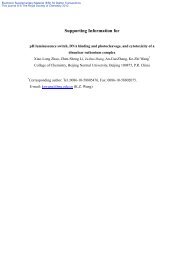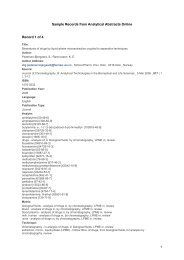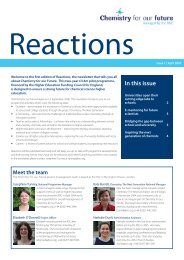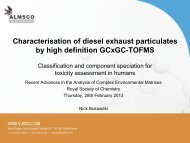Stimuli-Responsive Polymer Hydrogels as a New Class of Draw ...
Stimuli-Responsive Polymer Hydrogels as a New Class of Draw ...
Stimuli-Responsive Polymer Hydrogels as a New Class of Draw ...
You also want an ePaper? Increase the reach of your titles
YUMPU automatically turns print PDFs into web optimized ePapers that Google loves.
<strong>Stimuli</strong>-<strong>Responsive</strong> <strong>Polymer</strong> <strong>Hydrogels</strong> <strong>as</strong> a <strong>New</strong> Cl<strong>as</strong>s <strong>of</strong> <strong>Draw</strong><br />
Agent for Forward Osmosis Desalination<br />
Dan Li, Xinyi Zhang, Jianfeng Yao, George P. Simon, Huanting Wang*<br />
Experimental Section<br />
Supplementary Material (ESI) for Chemical Communications<br />
This journal is (c) The Royal Society <strong>of</strong> Chemistry 2011<br />
Supplementary Information<br />
Synthesis and characterization <strong>of</strong> hydrogels: The polymer syntheses were performed<br />
via radical polymerization <strong>of</strong> different monomers and crosslinker<br />
-N,N’-methylenebisacrylamide (MBA) (Sigma-Aldrich, 99%) in aqueous solution<br />
using ammonium persulfate (Sigma-Aldrich, ≥ 98.0%) <strong>as</strong> an initiator. Briefly, a<br />
monomer, including acrylamide (AM, Sigma-Aldrich, 99%), sodium acrylate (SA,<br />
Sigma-Aldrich, 99%), N-isopropylacrylamide (NIPAM, Sigma-Aldrich, 96%), or<br />
their mixture w<strong>as</strong> firstly completely dissolved in deionised water to form a 16.7 wt%<br />
monomer solution with a molar ratio <strong>of</strong> monomer, crosslinker and initiator <strong>of</strong><br />
100:1:0.5). The crosslinker and initiator were then dissolved in this solution, followed<br />
by deaeration via flowing nitrogen g<strong>as</strong> through the solution for 10 min. The resultant<br />
solution w<strong>as</strong> kept in an oven set at 50 °C for polymerization. <strong>Polymer</strong> hydrogels<br />
synthesized from acrylamide, sodium acrylate, N-isopropylacrylamide, or sodium<br />
acrylate and N-isopropylacrylamide (molar ratio 1:1) mixture were denoted <strong>as</strong> PAM,<br />
PSA, PNIPAM and PSA-NIPAM, respectively.<br />
The <strong>as</strong>-synthesized polymer hydrogels were taken from the bottles and cut into small<br />
pieces. The hydrogel pieces were then immersed in deionised water at 25 °C for 3<br />
days, in which the water w<strong>as</strong> exchanged every 4 h, to w<strong>as</strong>h away unreacted<br />
monomers and crosslinker. The hydrogels were ground into small particles using a<br />
mortar and pestle, followed by drying at 50°C in a vacuum oven. The dried gel<br />
particles were sieved, and those in the size range <strong>of</strong> 50 µm to 150 µm used for<br />
characterizations and FO and dewatering tests.<br />
S1
Supplementary Material (ESI) for Chemical Communications<br />
This journal is (c) The Royal Society <strong>of</strong> Chemistry 2011<br />
The samples were characterized by scanning electron microscopy (SEM) and<br />
Fourier-transform infrared spectroscopy (FTIR). SEM images were recorded with a<br />
Model JSM-6300F microscope (JEOL) at an accelerating voltage <strong>of</strong> 5 kV.<br />
Fourier-transform infrared spectra (FT-IR) were recorded for the samples embedded<br />
in KBr pellets with a GX Spectrometer (Perkin–Elmer).<br />
Testing <strong>of</strong> polymer hydrogels <strong>as</strong> draw agents in FO process: A commercial<br />
hydrophilic cellulose-b<strong>as</strong>ed FO membrane (provided by Hydration Technologies Inc.,<br />
Albany, OR) w<strong>as</strong> used. Before each test, the FO membrane w<strong>as</strong> immersed in a 2000<br />
ppm NaCl solution overnight. 1 g <strong>of</strong> polymer hydrogel powders w<strong>as</strong> placed on the<br />
one side <strong>of</strong> the membrane and the NaCl solution on the permeate side. As the water<br />
permeated through the membrane from the NaCl solution, driven by swelling <strong>of</strong><br />
polymer hydrogel powders, the weight <strong>of</strong> hydrogel powders incre<strong>as</strong>ed. Water flux<br />
w<strong>as</strong> determined by me<strong>as</strong>uring the weight change <strong>of</strong> the polymer hydrogel with time,<br />
and calculated by<br />
V<br />
Water flux =<br />
A×<br />
t<br />
where V is the volume <strong>of</strong> water permeating through the membrane (L), which is b<strong>as</strong>ed<br />
on the m<strong>as</strong>s incre<strong>as</strong>e <strong>of</strong> the swollen gel me<strong>as</strong>ured over a given period <strong>of</strong> time, t, (h) ;<br />
A is the effective area <strong>of</strong> FO membrane (m 2 ) used in the permeation cell.<br />
Dewatering <strong>of</strong> deswollen polymer hydrogels: The swollen polymer hydrogel after the<br />
FO test w<strong>as</strong> filled into a thermal mechanical dewatering cell. The apparatus for<br />
dewatering consists <strong>of</strong> a vertical cylinder with a movable piston through which a<br />
mechanical load is applied at the top <strong>of</strong> a confined bed <strong>of</strong> swollen gel particles. The<br />
inner diameter <strong>of</strong> the cell cylinder is 1.2 cm. The swollen polymer hydrogel w<strong>as</strong><br />
placed between the piston and a polysulfone UF membrane, which w<strong>as</strong> supported by<br />
a porous stainless steel disc. A load <strong>of</strong> 3MPa w<strong>as</strong> applied and kept constant for 2 min,<br />
resulting in shrinking <strong>of</strong> the gel particles. The water rele<strong>as</strong>ed from the polymer<br />
hydrogels w<strong>as</strong> free to flow through the UF membrane and the porous stainless steel<br />
disc. The dewatering experiments were carried at 25 °C and 50 °C, respectively. The<br />
amount <strong>of</strong> water rele<strong>as</strong>ed w<strong>as</strong> determined by taking the weight difference <strong>of</strong> the<br />
S2
polymer hydrogel before and after the dewatering test. Water recovery rate w<strong>as</strong><br />
derived from the weight <strong>of</strong> rele<strong>as</strong>ed water and the initial water content <strong>of</strong> the swollen<br />
polymer hydrogel.<br />
Wt<br />
Water recov<br />
ery rate = × 100%<br />
W<br />
o<br />
where Wt is the weight <strong>of</strong> water rele<strong>as</strong>ed in the dewatering test (g); Wo is the initial<br />
water weight <strong>of</strong> the swollen gel (g).<br />
Vt<br />
Water flux =<br />
A×<br />
t<br />
where V is the volume <strong>of</strong> water rele<strong>as</strong>ed in the dewatering test (L), which is<br />
calculated from the weight <strong>of</strong> water rele<strong>as</strong>ed in the dewatering test; A is the inner area<br />
<strong>of</strong> the cylindrical cell (m 2 ); t is the dewatering time (h).<br />
S-Figure 1 shows the SEM images <strong>of</strong> different polymer hydrogels. All samples have<br />
sizes ranging from 50 µm to 150 µm, <strong>as</strong> well <strong>as</strong> some small, fine particles. SEM<br />
images reveal that PAM and PSA particles possess smooth surfaces, where<strong>as</strong><br />
PNIPAM and PSA-NIPAM have rough surfaces.<br />
S-Figure 1. SEM images <strong>of</strong> polymer hydrogel particles: (a) at Low magnification and<br />
(b) at high magnification.<br />
Supplementary Material (ESI) for Chemical Communications<br />
This journal is (c) The Royal Society <strong>of</strong> Chemistry 2011<br />
S3
S-Figure 2 shows the FTIR spectra <strong>of</strong> four different polymer hydrogels, including<br />
PAM, PSA, PNIPAN and PSA-NIPAM. The FTIR spectrum <strong>of</strong> PAM shows a broad<br />
absorption band at 3430 cm −1 due to the N–H stretching <strong>of</strong> amide groups <strong>of</strong><br />
acrylamide units. Two peaks at around 1663 and 1608 cm −1 arise from amide-I and<br />
amide-II <strong>of</strong> acrylamide units. C–N and C–H stretching bands appear at 1440 and<br />
2922cm −1 , respectively, further confirming the presence <strong>of</strong> amide groups. 1 In<br />
spectrum <strong>of</strong> PSA, the absorbance at 2940 cm -1 is attributed to the –CH2 stretching<br />
vibration, which is supported by the presence <strong>of</strong> –CH2 bending vibration at 1455 cm -1 .<br />
Two strong absorption peaks are observed at around 1570 and 1410 cm −1 , which are<br />
<strong>as</strong>signed to the C=O stretching vibration <strong>of</strong> the ionic carboxyl group (–COO−). 2 In the<br />
FTIR spectrum <strong>of</strong> PNIPAM, the main peak <strong>as</strong>signments are <strong>as</strong> follows: 3292 cm -1<br />
(secondary amide N-H stretching), 2970 cm -1 (-CH3 <strong>as</strong>ymmetric stretching), 1650<br />
cm -1 (secondary amide C=O stretching, aka amide I bond), and 1550 cm -1 (secondary<br />
amide C=O stretching, aka amide II bond). 3 Similar peaks in PSA or PNIPAM can be<br />
observed in the spectrum <strong>of</strong> PSA-NIPAM sample, confirming the presence <strong>of</strong> NIPAM<br />
and SA units in the hydrogel.<br />
Supplementary Material (ESI) for Chemical Communications<br />
This journal is (c) The Royal Society <strong>of</strong> Chemistry 2011<br />
PSA<br />
PSA-NIPAM<br />
PNIPAM<br />
PAM<br />
4000 3000 2000 1000<br />
Wavelength (cm-1)<br />
S-Figure 2. FTIR spectra <strong>of</strong> PAM, PSA, PNIPAM and PSA-NIPAM.<br />
S4
S-Figure 3. Water recovery for swollen hydrogels (PAM, PSA, PNIPAM and<br />
PSA-NIPAM) with different water loadings after 2 min dewatering process at ambient<br />
temperature.<br />
References<br />
[1] Y. M. Mohan, J. P. Dickson, K. E. Geckeler, Polym. Int. 2007, 56, 175.<br />
[2] R. S. Tomar, I. Gupta, R. Singhal, A. K. Nagpal, Polym. Pl<strong>as</strong>tics Tech. Eng. 2007,<br />
46, 481.<br />
Supplementary Material (ESI) for Chemical Communications<br />
This journal is (c) The Royal Society <strong>of</strong> Chemistry 2011<br />
[3] Y. Cui, C. Tao, Y. Tian, Q. He, J. Li, Langmuir 2006, 22, 8205.<br />
S5





